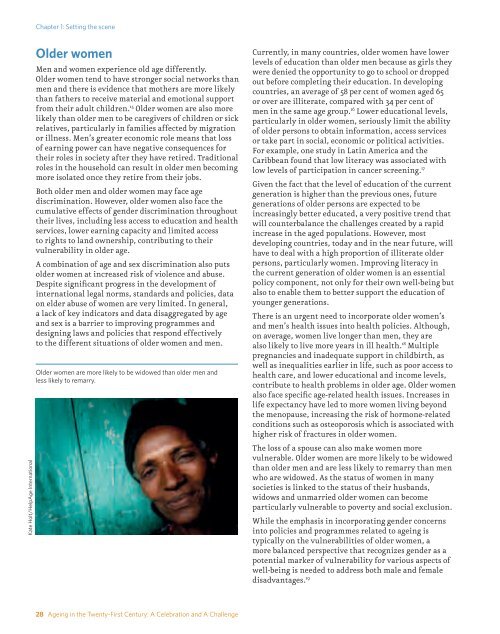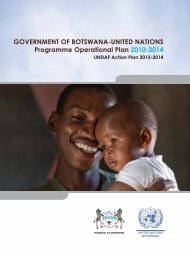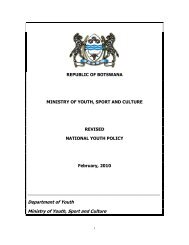Ageing in the Twenty-First Century: - HelpAge International
Ageing in the Twenty-First Century: - HelpAge International
Ageing in the Twenty-First Century: - HelpAge International
Create successful ePaper yourself
Turn your PDF publications into a flip-book with our unique Google optimized e-Paper software.
Chapter 1: Sett<strong>in</strong>g <strong>the</strong> scene<br />
Kate Holt/<strong>HelpAge</strong> <strong>International</strong><br />
Older women<br />
Men and women experience old age differently.<br />
Older women tend to have stronger social networks than<br />
men and <strong>the</strong>re is evidence that mo<strong>the</strong>rs are more likely<br />
than fa<strong>the</strong>rs to receive material and emotional support<br />
from <strong>the</strong>ir adult children. 15 Older women are also more<br />
likely than older men to be caregivers of children or sick<br />
relatives, particularly <strong>in</strong> families affected by migration<br />
or illness. Men’s greater economic role means that loss<br />
of earn<strong>in</strong>g power can have negative consequences for<br />
<strong>the</strong>ir roles <strong>in</strong> society after <strong>the</strong>y have retired. Traditional<br />
roles <strong>in</strong> <strong>the</strong> household can result <strong>in</strong> older men becom<strong>in</strong>g<br />
more isolated once <strong>the</strong>y retire from <strong>the</strong>ir jobs.<br />
Both older men and older women may face age<br />
discrim<strong>in</strong>ation. However, older women also face <strong>the</strong><br />
cumulative effects of gender discrim<strong>in</strong>ation throughout<br />
<strong>the</strong>ir lives, <strong>in</strong>clud<strong>in</strong>g less access to education and health<br />
services, lower earn<strong>in</strong>g capacity and limited access<br />
to rights to land ownership, contribut<strong>in</strong>g to <strong>the</strong>ir<br />
vulnerability <strong>in</strong> older age.<br />
A comb<strong>in</strong>ation of age and sex discrim<strong>in</strong>ation also puts<br />
older women at <strong>in</strong>creased risk of violence and abuse.<br />
Despite significant progress <strong>in</strong> <strong>the</strong> development of<br />
<strong>in</strong>ternational legal norms, standards and policies, data<br />
on elder abuse of women are very limited. In general,<br />
a lack of key <strong>in</strong>dicators and data disaggregated by age<br />
and sex is a barrier to improv<strong>in</strong>g programmes and<br />
design<strong>in</strong>g laws and policies that respond effectively<br />
to <strong>the</strong> different situations of older women and men.<br />
Older women are more likely to be widowed than older men and<br />
less likely to remarry.<br />
Currently, <strong>in</strong> many countries, older women have lower<br />
levels of education than older men because as girls <strong>the</strong>y<br />
were denied <strong>the</strong> opportunity to go to school or dropped<br />
out before complet<strong>in</strong>g <strong>the</strong>ir education. In develop<strong>in</strong>g<br />
countries, an average of 58 per cent of women aged 65<br />
or over are illiterate, compared with 34 per cent of<br />
men <strong>in</strong> <strong>the</strong> same age group. 16 Lower educational levels,<br />
particularly <strong>in</strong> older women, seriously limit <strong>the</strong> ability<br />
of older persons to obta<strong>in</strong> <strong>in</strong>formation, access services<br />
or take part <strong>in</strong> social, economic or political activities.<br />
For example, one study <strong>in</strong> Lat<strong>in</strong> America and <strong>the</strong><br />
Caribbean found that low literacy was associated with<br />
low levels of participation <strong>in</strong> cancer screen<strong>in</strong>g. 17<br />
Given <strong>the</strong> fact that <strong>the</strong> level of education of <strong>the</strong> current<br />
generation is higher than <strong>the</strong> previous ones, future<br />
generations of older persons are expected to be<br />
<strong>in</strong>creas<strong>in</strong>gly better educated, a very positive trend that<br />
will counterbalance <strong>the</strong> challenges created by a rapid<br />
<strong>in</strong>crease <strong>in</strong> <strong>the</strong> aged populations. However, most<br />
develop<strong>in</strong>g countries, today and <strong>in</strong> <strong>the</strong> near future, will<br />
have to deal with a high proportion of illiterate older<br />
persons, particularly women. Improv<strong>in</strong>g literacy <strong>in</strong><br />
<strong>the</strong> current generation of older women is an essential<br />
policy component, not only for <strong>the</strong>ir own well-be<strong>in</strong>g but<br />
also to enable <strong>the</strong>m to better support <strong>the</strong> education of<br />
younger generations.<br />
There is an urgent need to <strong>in</strong>corporate older women’s<br />
and men’s health issues <strong>in</strong>to health policies. Although,<br />
on average, women live longer than men, <strong>the</strong>y are<br />
also likely to live more years <strong>in</strong> ill health. 18 Multiple<br />
pregnancies and <strong>in</strong>adequate support <strong>in</strong> childbirth, as<br />
well as <strong>in</strong>equalities earlier <strong>in</strong> life, such as poor access to<br />
health care, and lower educational and <strong>in</strong>come levels,<br />
contribute to health problems <strong>in</strong> older age. Older women<br />
also face specific age-related health issues. Increases <strong>in</strong><br />
life expectancy have led to more women liv<strong>in</strong>g beyond<br />
<strong>the</strong> menopause, <strong>in</strong>creas<strong>in</strong>g <strong>the</strong> risk of hormone-related<br />
conditions such as osteoporosis which is associated with<br />
higher risk of fractures <strong>in</strong> older women.<br />
The loss of a spouse can also make women more<br />
vulnerable. Older women are more likely to be widowed<br />
than older men and are less likely to remarry than men<br />
who are widowed. As <strong>the</strong> status of women <strong>in</strong> many<br />
societies is l<strong>in</strong>ked to <strong>the</strong> status of <strong>the</strong>ir husbands,<br />
widows and unmarried older women can become<br />
particularly vulnerable to poverty and social exclusion.<br />
While <strong>the</strong> emphasis <strong>in</strong> <strong>in</strong>corporat<strong>in</strong>g gender concerns<br />
<strong>in</strong>to policies and programmes related to age<strong>in</strong>g is<br />
typically on <strong>the</strong> vulnerabilities of older women, a<br />
more balanced perspective that recognizes gender as a<br />
potential marker of vulnerability for various aspects of<br />
well-be<strong>in</strong>g is needed to address both male and female<br />
disadvantages. 19<br />
28 <strong>Age<strong>in</strong>g</strong> <strong>in</strong> <strong>the</strong> <strong>Twenty</strong>-<strong>First</strong> <strong>Century</strong>: A Celebration and A Challenge







